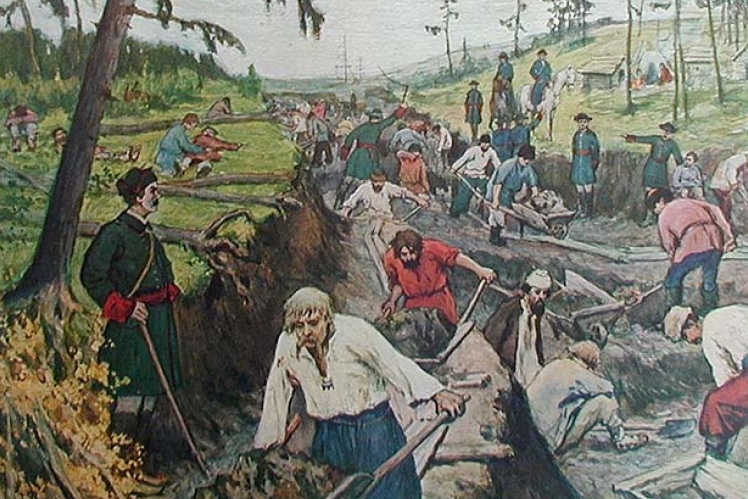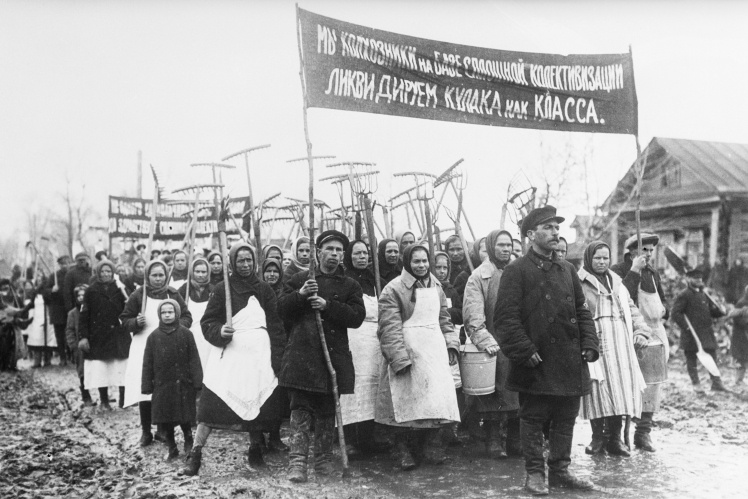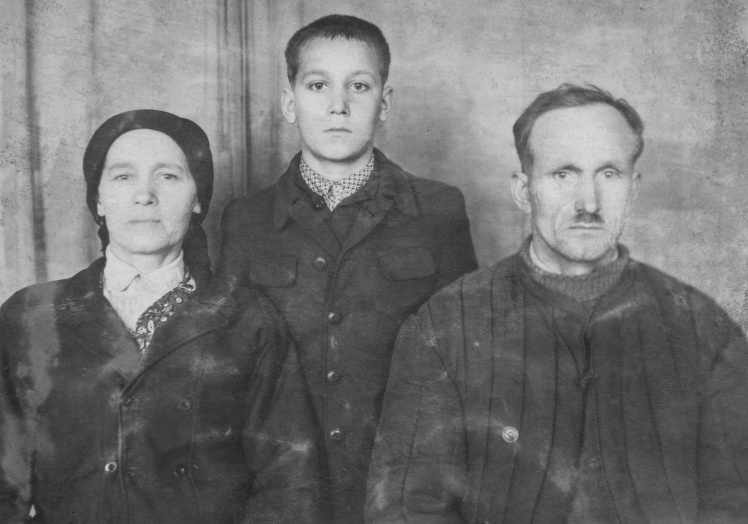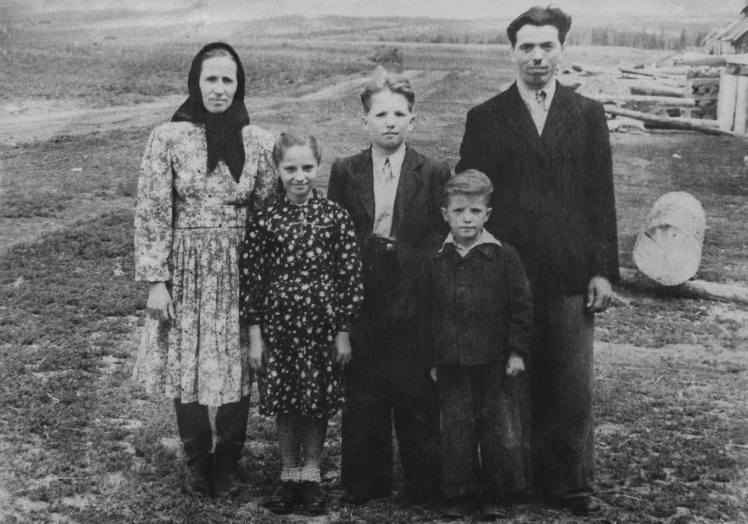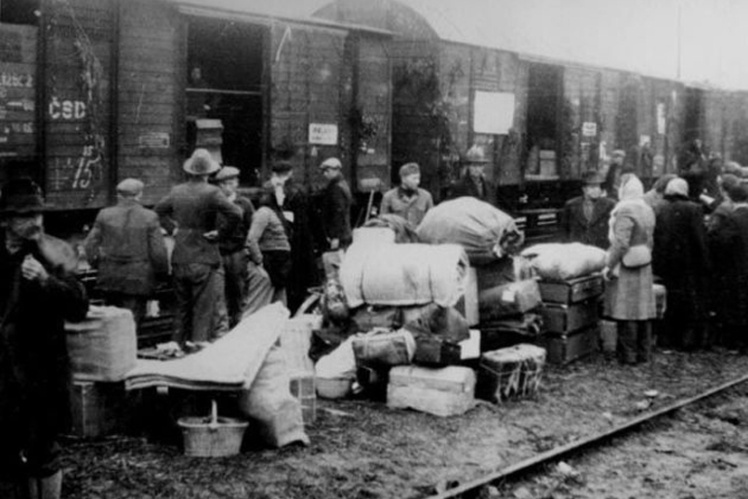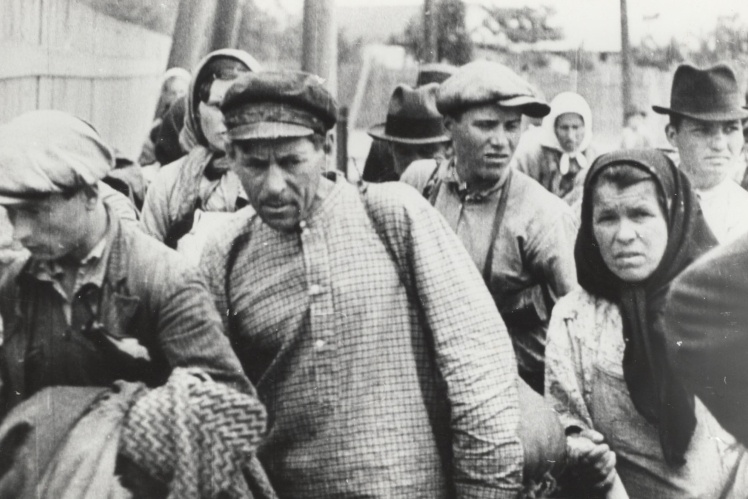Deportations of Ukrainians in the Russian Empire
The first mass deportations from Ukraine on national grounds took place at the beginning of the 18th century. Then, by order of the Russian Tsar Peter I, thousands of Ukrainians were forcibly sent to hard work to build St. Petersburg and lay the Ladoga Canal.
For the first two years, ten thousand Cossacks annually were sent to work just for the construction of the canal. Then the quota was halved. But not because they decided to feel sorry for the Cossacks. Itʼs just that Tsar Peter, who declared himself emperor, got involved in a military adventure — he demanded to conquer the way to India and started a campaign in the area of the Caspian Sea. Therefore, part of the Ukrainian Cossacks was simply diverted from construction work to the war.
Oleksandr Moravovʼs painting “Construction of the Ladoga Canal”, 1910.
Wikimedia / «Бабель»
St. Petersburg and the Ladoga Canal were built in very difficult conditions — swampy terrain, frequent rains, a shortage of food, and mocking by the Russian officers-supervisors. According to rough estimates, at least 30% of Ukrainians died in construction work. This is about twice as many as died during the Caspian campaign.
Another large-scale deportation of the population of Ukraine was the forced resettlement of residents of the Right Bank Ukraine to the Left Bank, which was arranged by order of Peter I in 1711-1712. At that time, Ukraine was divided along the Dnipro River between the Muscovite Kingdom and the Polish-Lithuanian Commonwealth. The Moscow state increasingly limited the rights and autonomy of the Hetmanship, the Ukrainian state founded by Bohdan Khmelnitsky. Hetman Ivan Mazepa tried to escape from Moscowʼs rule by uniting with the Swedish king Charles XII, but was defeated at Poltava in 1709.
Gustav Olaf Tsederströmʼs painting “Karl XII and Ivan Mazepa after the Battle of Poltava”, 1879.
Wikimedia / «Бабель»
The very next year, 1710, Moscow troops invaded the Right BankUkraine and began to advance south. Then the Ottoman Empire intervened and in May 1711 defeated the Moscow army on the banks of the Prut River. After the defeat, Peter I had to conclude a peace agreement. One of its main conditions was that the Muscovite kingdom withdraws from Right-Bank Ukraine, leaving only Kyiv behind.
In September 1711, Peter I issued an order obliging all right-bank Cossack regiments to move to the Left Bank. For the civilian population, formally resettlement was voluntary, but there were few willing ones. Then they began to be resettled by force, livestock and grain were taken, and towns and villages were destroyed — that is, the Russians used the “scorched earth” tactic. The main period of deportation fell on the winter of 1711-1712. During this period, according to various sources, from 100 to 200 thousand people were resettled on the Left Bank. In new places, they were simply left to fend for themselves, without providing either housing or provisions. As a result of this deportation, an international scandal arose. The Polish-Lithuanian Commonwealth demanded Moscowʼs permission to return the deportees. But the tsarist authorities covered themselves with a decree on “voluntary” resettlement, and in fact forbade the resettled to return to the Right Bank.
Vasyl Volkovʼs painting “Peter I visits the commanding hetman Polubotko in the casemate of the Peter and Paul Fortress in 1724”, 1900.
Wikimedia / «Бабель»
Similar tactics of deportation and “scorched earth” were used by the Russians during the First World War, when they occupied Eastern Galicia in 1914-1915. During this period, approximately 13,000 Ukrainians were deported deep into Russia. Among them was, in particular, Metropolitan of the Ukrainian Greek Catholic Church Andrey Sheptytskyi.
Metropolitan Andrey Sheptytskyi (seated in the first row in the middle) with the bishops of the Ukrainian Greek Catholic Church at a meeting in Lviv, 1927.
Wikimedia / «Бабель»
Deportations of Ukrainians to the USSR
Deportations of various peoples in Soviet times became almost the main instrument of state policy. Especially mass deportations were during the rule of Joseph Stalin — in the 1920s-1950s. In total, approximately six million people were affected by forced relocations, of which almost one and a half million died. Among the deported were many Ukrainians.
The Soviet authorities began the first mass deportations of Ukrainians already in the second half of the 1920s, as part of “unkurkuling”. The Bolsheviks called wealthy peasants who had large farms and hired workers “kurkuls”. Their property was forcibly taken from them, and they themselves were sent to exile, to camps, or shot. By the mid-1930s, approximately 150,000 people were evicted from various Ukrainian regions to the north of the USSR and to Siberia.
Soviet peasants, 1923. Soviet peasants during mass collectivization, 1930. Soviet peasants with a banner with a call to fight against the "kurkuls", 1931.
Getty Images / «Babel'»
With the beginning of the Second World War, the USSR occupied Western Ukraine. Here, the Soviet regime immediately began mass deportations, only at an accelerated pace. Only from the end of 1939 and during 1940, 10 to 20% of the population was taken from Western Ukraine to Siberia, the Volga region, Kazakhstan and the north of the USSR, according to various estimates.
The most massive wave of deportations occurred between May 22 and June 20, 1941, on the eve of Germanyʼs attack on the USSR. The head of the NKVD, Lavrentiy Beria, was personally responsible for its organization. People were evicted in whole families and were not given time to pack. After filtering, the men were mostly imprisoned and sent to camps, where most of them died. And women and children were taken to special settlements in the most remote regions of the Soviet Union. This wave of deportation covered approximately 300,000 people.
In 1944, Soviet rule returned to Western Ukraine. From then until the beginning of the 1950s, almost half a million Ukrainians were deported. Operation “West” in 1947 was the most revealing, when approximately 80,000 people were deported in one day. This is how the Soviet authorities fought the liberation movement in Western Ukraine. Whole families were evicted, even those who were only suspected of collaborating with the Ukrainian Insurgent Army.
The Pylyp family a month after being forcibly deported to Siberia in the village of Yermakivka, Irkutsk region, 1951. They were deported from the Ukrainian village of Hrabiv in the Carpathians. A Ukrainian family one month after the forced deportation to Siberia in the village of Kvitok, Irkutsk region, 1951. They were deported from the Ukrainian village of Hrabiv in the Carpathians.
Getty Images / «Babel'»
The operation began at two oʼclock in the morning on October 21, 1947 in the Lviv, Stanislav (now Ivano-Frankivsk), Ternopil, and Rivne regions. It involved almost 30,000 soldiers and approximately 16,000 people from other law enforcement agencies. They surrounded villages, conducted searches and sent people in trucks to railway stations based on lists. And from there — in wagons to Kazakhstan and remote regions of Siberia. The authorities opened fire on those who tried to escape from the encirclement.
Who else did the Russians deport from Ukrainian territories
During the 18th and 19th centuries, Nogai Tatars who lived in the Black Sea and Azov regions experienced several waves of deportation. First, they were evicted to the steppes between the Don and the Kuban, then the authorities tried to expel them to the Urals. Because of this, the Nogai rebelled. The uprising was brutally suppressed by the Russian army, and the Nogais had to flee to the Caucasus.
During the First World War, approximately 150,000 German colonists were forcibly removed from Volyn to the Volga region, the Urals, the Caucasus and Siberia. Germans, Poles, Czechs and representatives of other nations who lived on the territory of modern Ukraine were deported en masse even under the Stalinist regime.
Polish families are deported to Siberia, 1940-1941. Romanian refugees after the Soviet occupation of Bessarabia and Bukovyna, 1940. A Ukrainian family returns home after being exiled to Siberia, 1965.
Wikimedia / «Бабель»; Getty Images / «Babel'»
Crimea wasnʼt the most unlucky. After the Russian occupation in the second half of the 18th century, Greeks, Bulgarians, and Armenians were forcibly evicted from there. But the Russian authorities exterminated the Crimean Tatars in a particularly methodical way. From the beginning of the occupation to the end of the 19th century, the Crimean Tatar population of the peninsula decreased from one million to 200 thousand people.
“Migration of the Crimean Tatar family”, drawing by an unknown artist, 1844.
Getty Images / «Babel'»
During the Soviet era, oppression and repression of the Crimean Tatars continued. But the most terrible thing happened in 1944 — the deportation of the entire nation. Then Stalin declared all Crimean Tatars “traitors to the Motherland” and ordered their deportation from Crimea. During May-June 1944, 200,000 to 400,000 Crimean Tatars were forcibly deported to remote regions of Central Asia, the Urals, and Siberia. They were forbidden to return to the peninsula until the collapse of the Soviet Union. Ukraine, Latvia, Lithuania, and Canada recognized the deportation of the Crimean Tatars as genocide. And after the occupation of the peninsula in 2014, Russia again started repressions against the Crimean Tatars.
Anniversary of the deportation of Crimean Tatars in Crimea, 1994. Since 2016, the Day of Remembrance of the Victims of the Genocide of the Crimean Tatar People has been commemorated in Ukraine every year on May 18.
Getty Images / «Babel'»
Translated from Ukrainian by Anton Semyzhenko.
We remember all the crimes of the Russians, even if they were several hundred years ago. So that we can continue to do this in the future, support Babel: via Patreon 🔸 [email protected]🔸donate in cryptocurrency🔸in Ukrainian hryvnia.
